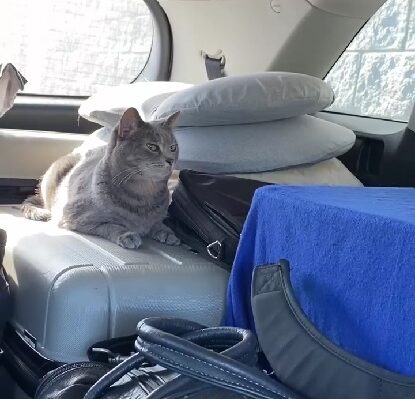
Traveling with a cat by car can be a daunting experience, whether you’re headed to the vet, going on vacation, or moving to a new home. Cats are creatures of habit, and taking them out of their comfort zone can lead to stress and anxiety. Understanding how to relax your cat when traveling can help make the journey smoother for both you and your feline companion. I personally travel by car with my cat every year over long distances, and over the years, I’ve accumulated a wealth of tips on how to make this process easier for both you and your cat.
Why Does Traveling Stress Cats?
Car travel can be stressful for cats because they’re territorial animals that feel secure in their familiar surroundings. Cats mark their space with pheromones, which help them feel safe. When you’re traveling by car, you’re taking them away from that environment, which can cause anxiety. Pheromones are natural chemicals cats release from their chin, cheeks, forehead, and tail to communicate comfort. To help relax your cat during car travel, you can use methods that tap into these calming signals, among other tips.
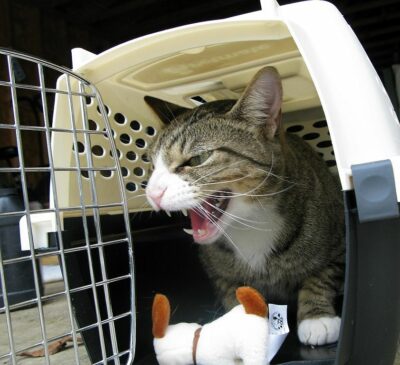
My 8 Tips to Relax Your Cat When Traveling By Car
These tips and hacks are ones I’ve collected over the past nine years of traveling long distances with my cat each year.
1. A Partner Can Make the Trip Much Less Stressful for Your Cat
Traveling with a partner can help share the responsibilities of caring for your cat during the trip. One person can focus on driving while the other attends to your cat’s needs, from offering comfort to checking on their well-being. This reduces stress for both you and your cat, creating a calmer journey.
2. Get Your Cat Comfortable with the Carrier
A familiar and cozy carrier is key to reducing travel stress. Choose a spacious but secure carrier and introduce it well before the trip. Leave it open at home with a favorite blanket, toy, or an old shirt with your scent inside. This helps your cat associate the carrier with safety rather than stress. Before traveling, spray the inside with pheromones to create a calming effect.
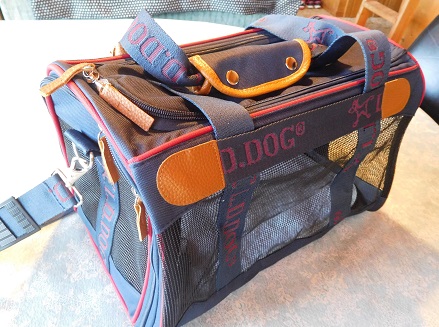
3. Familiarize Your Cat with the Car Before Travel
To make travel day less stressful, start getting your cat used to the car at least a week before. Each day, place your cat inside the parked car with you, offering treats, playing, and letting her relax in the space. This way, when the trip begins, she’ll already feel somewhat accustomed to the car environment, making the transition smoother and reducing agitation. My husband has successfully used this technique with our cat, Sophie. A week before the trip, he places her in the car each day, giving her love, treats, and playtime while she’s inside. By the time we’re ready to hit the road, she’s already comfortable and accustomed to being in the car, which makes the trip much less stressful for her.
4. Set Up a High Surface Next to the Window for Your Cat to See
My cat, Sophie, feels more at ease when she has a high vantage point next to the window. To make the trip more comfortable for her, we set up a sturdy surface near the window—such as a tall, thick cardboard box or a stable plastic bin—at a height that allows her to jump up and sit while watching the world go by. Cats often feel more secure when they can observe their surroundings from a higher perspective, and having this setup helps Sophie feel less stressed during the ride.
My Cat Relaxed Traveling in the Car
5. Reduce Plastic Noises for a Quieter Trip
One thing I’ve learned from traveling with my cat, Sophie, is that plastic bags can be startling with their crunchy, crinkling noises, especially when she’s trying to relax or sleep during the trip. To avoid disturbing her, I make sure to pack all my essential snacks and items in fabric bags instead of plastic ones. This simple change helps create a quieter environment inside the car and ensures that Sophie isn’t awakened or stressed by unexpected noises. By paying attention to these little details, I can make the journey more peaceful and comfortable for her, allowing both of us to focus on the road ahead.
6. Spray Pheromones on Car And Carrier
One of the most effective ways to relax your cat during travel is by using pheromone sprays. These sprays mimic the natural pheromones cats use to mark their territory. By spraying the car and your cat’s kennel or soft pet carrier, you can help your cat feel more at ease in unfamiliar environments. Spray the car (in hidden areas) and carrier about an hour before the trip for better results.
The pheromone spray is also perfect for hotel rooms. Make sure to spray it in the corners before letting your cat inside. That’s what we do with Sophie, and she enters the room like she’s always been there! It works! I also use a pheromone plug diffuser, which is more effective when preparing your cat for a smooth transition to a new, permanent environment. This is because it takes longer for the pheromones to spread throughout the entire space.
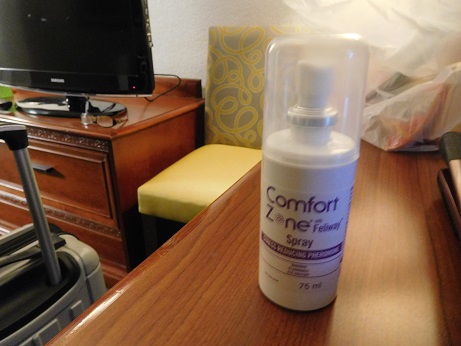
7. Homeopathic Drops for Extra Relief
In addition to pheromones, homeopathic remedies like Rescue Remedy can offer additional comfort for your cat during travel. This natural remedy works well for cats that suffer from motion sickness or anxiety during long trips. It’s made from a combination of flower essences, including Rock Rose, Clematis, and Cherry Plum. I’ve used it with my own cat, Sophie, and it’s worked very well to alleviate drooling and discomfort during car rides.
You can add 4 drops of Rescue Remedy to your cat’s wet food before the trip. This remedy is safe and effective, with no known side effects, and can be used for other stressful situations, like vet visits or new environments. These drops can make your cat a little sleepier, but that’s good if you are traveling.
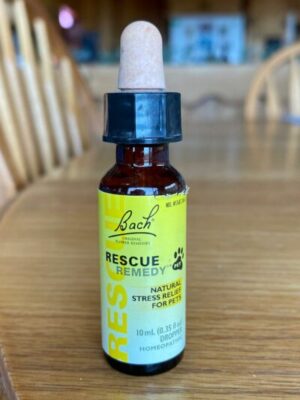
8. Calm Your Cat with Music or White Noise
Some cats find comfort in calming sounds, such as soft music or white noise. Consider using a portable sound machine or playing soft classical music in the car to help soothe your cat during the trip. This simple trick can reduce anxiety and create a more relaxing atmosphere. In fact, a study published in the Journal of Feline Medicine and Surgery found that cat-specific music significantly reduced stress and anxiety in cats, making it a valuable tool for relaxing your cat during travel.
10. Comforting Touch During the Trip
A quick petting session before and during the trip can significantly help calm your cat. Your touch provides reassurance, helping to reduce anxiety and stress. If your cat starts meowing or seems unsettled, gently talk to her and offer soothing strokes to calm her down. We use this technique with our cat, Sophie, and it’s incredibly effective in keeping her relaxed throughout the journey.
11. Provide Safe and Stress-Free Breaks
If you’re traveling by car for an extended period, plan regular stops to allow your cat to stretch, drink water, and use the litter box if needed. Always prioritize safety—never open the carrier in an unfamiliar area unless your cat is securely harnessed and leashed. If you do let your cat out inside the car, ensure all doors and windows remain closed to prevent any escapes. Some cats may prefer to stay inside their carrier, so it’s important to monitor their comfort and adjust accordingly. If your journey extends beyond 24 hours, consider staying in a pet-friendly hotel overnight. This will give your cat a chance to rest, eat, and do its business comfortably, as holding urine and feces for too long can be unhealthy for them.
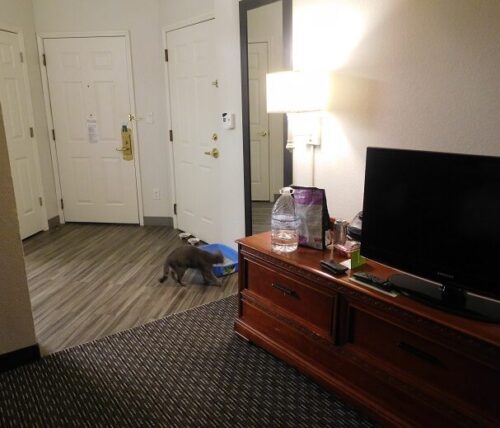
What If Your Cat Doesn’t Calm Down?
If you’ve tried all the natural remedies and your cat is still highly stressed, it might be time to consult your vet for prescription medications. A veterinarian can recommend sedatives or other calming treatments tailored to your cat’s specific needs and the duration of the trip. It’s always a good idea to seek professional advice to ensure your cat’s safety and comfort. If your cat tends to be skittish or very nervous by nature, consider getting the medication in advance, so you’re prepared if the other methods don’t work.
What to Do If Your Cat Drools During the Travel
- Comfort Your Cat: Drooling can quickly lead to excessive wetness, soaking your cat’s front body and potentially causing dehydration (we learned the hard way on our first trip). If you notice your cat drooling, immediately dry their mouth and face with a tissue, and offer comfort through soft talking or gentle petting to help calm them, it works. This is why traveling with a partner is so helpful—one person can focus on your cat’s well-being while the other drives safely.
- Hydration: Ensure your cat has access to water during longer trips. Dehydration can exacerbate drooling, so keeping your cat hydrated is important.
- Frequent Breaks: If the trip is long, make frequent stops so your cat can rest and recover from any stress or motion sickness.
Final Thoughts on How to Relax Your Cat When Traveling
Traveling with a cat doesn’t have to be a stressful experience. By using pheromone sprays, homeopathic remedies, and creating a familiar environment for your cat, you can make the trip more enjoyable for both of you. Remember that every cat is different, so it may take some trial and error to find the best combination of methods for your feline friend. Safe travels!
Leave a Reply